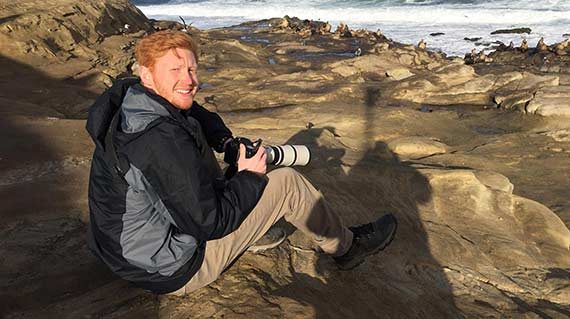
Your Guide: Jacob Roalef
Tours: Alaska, Arizona, California, Colorado, Florida, Maine, Minnesota, Ohio, Texas, Wyoming, Birding Ecotours (Worldwide)
Maine (and the northeast region of the United States in general) offers a great mixed bag of birding through its diverse habitats and high latitude location. Many migrant species call this area their home in the summer as they stake out territories and breed. The overlap between the more southern breeders and northern breeders is rarely seen elsewhere, meaning Maine offers a unique chance of some fantastic birding generating some good lists. The habitats on display range from coastal saltwater marshes to sandy-plains grasslands, high altitude mountain tops of the Appalachians, expansive boreal forests, and unique clusters of offshore islands inhabited by puffins and other charismatic wildlife. Each habitat contains its own picturesque beauty along with key bird species to see. This nine-day tour explores the best this region has to offer. On this tour, we focus on Maine, but also foray into New Hampshire and time-permitting into Vermont.
The trip will begin by exploring Scarborough Marsh, a massive saltwater estuary home to a large population of both Saltmarsh and Nelson’s Sparrows. From here we will continue along to the Kennebunk Plains and into the White Mountains National Forest of New Hampshire for our first taste of boreal forest birding. One of the best locations for breeding Bicknell’s Thrush is near the top of Mount Washington (from roadside pull-offs, so no need for a strenuous hike), the highest peak in the northeast (6,200 feet, almost 2,000 meters). We will continue our boreal birding experience scoring a myriad of thrush, warbler, and flycatcher species, all of which will be on their established breeding grounds by June. Black-backed Woodpecker, Canada (Grey) Jay, Spruce Grouse, Boreal Chickadee, Red Crossbill, and other charismatic birds of the taiga forests, are all possibilities. Eventually we will make it back to Maine’s coastline and begin our exploration of the ocean. With two pelagic boat trips planned, we will hopefully experience up-close-and-personal views of Atlantic Puffin, Razorbill, Common Murre, Black Guillemot, Arctic Tern and more as we visit the numerous offshore islands. Finally, the trip concludes with a journey through the jaw-droppingly beautiful Acadia National Park, full of scenic viewpoints and great breeding birds. This New England birding and wildlife holiday might also generate some non-avian finds, such as Ocean Sunfish, Grey Seal, Humpback, Fin and Common Minke Whales, American Beaver, North American Porcupine, American Black Bear and Moose.
Date-wise, this Maine and New Hampshire birdwatching tour is combinable with our Alaska birding tour and extension (and sometimes with other USA birding tours of ours) but if you combine with Alaska you’re in for a long flight across North America – a similar distance to flying from London to Maine.
The boat departure to Machias Seal Island featured on Day 6 of this tour is sometimes replaced with a different pelagic trip to Seal Island National Wildlife Refuge. This refuge and series of islands are located in more southern waters of Maine and features a restored seabird colony full of Atlantic Puffins, Razorbills, and Arctic and Common Terns. Additionally, this area features the largest colony of Great Cormorants found in Maine. With any luck, there is also the potential for a surprise star bird nicknamed “Troppy”, a Red-billed Tropicbird that has amazingly called these islands home for over 15 summers in a row! We never know until about early to mid May each year if this rather out of place, beautiful tropical seabird returns. Please note that in years we make this itinerary change, we also reverse the order of the itinerary because the alternate boat trip is further south, making logistics work better this way.
We will take a maximum of eight participants. On rare occasion we may extend the maximum to ten participants.
Duration: 9 days
Limit: 4 – 8
Date: 02 June – 10 June 2027
Start: Portland, Maine
End: Portland, Maine
Price:
US$5,268 per person sharing assuming 4 – 8 participants
Single supplement: US$922
We can run the same trip at a price similar to the larger group price for 2 tour participants, if they rent their own vehicle and pay for fuel – please e-mail [email protected] for details.

Tours: Alaska, Arizona, California, Colorado, Florida, Maine, Minnesota, Ohio, Texas, Wyoming, Birding Ecotours (Worldwide)
COASTAL MAINE:
20-26 June 2009
Top 10 lists are voted upon by the participants at the completion of each tour.
1 – Spruce Grouse
2 – Atlantic Puffin
3 – Chestnut-sided Warbler
4 – Common Murre
5 – Red-necked Grebe
6 – Bobolink
7 – Northern Goshawk
8 – Yellow-bellied Flycatcher
9 – Golden-crowned Kinglet
10 – Common Eider
Additional sightings included Gray Seals at Machias Seal Island, Moose tracks in several locations, a very close Porcupine at Schoodic Point, a Gray Fox crossing a blueberry barren, and a Raccoon on rocks offshore from Quoddy Head Light, much too close to the surf. We watched a female Snapping Turtle that appeared to have laid her eggs just before we arrived. A juvenile Hairy Woodpecker with yellow instead of red on top of its head caused us to think about American Three-toed Woodpecker, until we realized that none of the other field marks fit. And we had wonderful views of two beautiful Luna Moths.